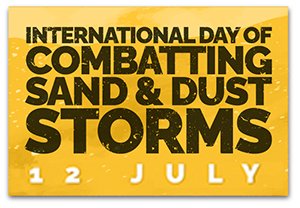PURPOSE: At least 25% of global dust emissions originate from human activities, and in some areas, desert dust has doubled in the 20th century. The impact of this phenomena is difficult to control, as human activity in one part of the world can cause sand and dust storms in another region. However, just as sand and dust storms are caused by human activities, these storms can also be reduced through human actions. The United Nations General Assembly stressed the need for cooperation at the global and regional levels, with a view to preventing, managing and mitigating the effects of sand and dust storms through the enhancement of early warning systems and the sharing of climate and weather information to forecast sand and dust storms. The General Assembly reaffirmed that resilient action to combat and reduce sand and dust storms requires a better understanding of the severe multidimensional impacts of sand and dust storms, including the deterioration of the health, well-being and livelihood of people, increased desertification and land degradation, deforestation, loss of biodiversity and land productivity, threatening food security, and their impact on sustainable economic growth.
FORUM: ''Combat SDS risks and mitigate their impacts.'' International Day of Combatting Sand and Dust Storms 2024. Sand and dust storms are an essential element of the Earth’s natural bio-chemical cycles, but are also caused in part by human-induced drivers, including climate change, and unsustainable land management and water use. In turn, sand and dust storms contribute to climate change and air pollution. Sand and dust storms’ impacts are felt in all regions of the world, both in developed and developing countries, and pose severe challenges to achieving 11 of the 17 Sustainable Development Goals, especially: SDG-2 : Zero hunger — SDG-3 : Health for all — SDG-6 : Water and sanitation — SDG-8 : Economic growth — SDG-11 : Sustainable Cities and societies — SDG-13 : Climate action, and — SDG-15 : Biodiversity forests and desertification. Follow the conversations with the hashtags: #12july, #sandstorms, #duststorms.
EVENTS: On July 12th, a High level Panel Discussion and several events were organized around the world. At the UNHQ; The 2nd edition will be, co-organized by the Permanent Missions of Iraq, the Islamic Republic of Iran, and Senegal at the United Nations Headquarters in New York, featured various speakers from organizations collaborating in the United Nations SDS Coalition. At the same time, the World Meteorological Organization (WMO) will host a webinar bringing together stakeholders from different regions.
PODCASTS: The IPCC Sixth Assessment Report provides a more detailed regional assessment of climate change, including a focus on useful information that can inform risk assessment, adaptation, and other decision-making, and a new framework that helps translate physical changes in the climate – heat, cold, rain, drought, snow, wind, coastal flooding and more – into what they mean for society and ecosystems Listen to the audio-podcast!
WHY WE CELEBRATE THE DAY?
HOW TO GET INVOLVED!
PARTNERSHIPS
Recognizing that sand and dust storms and their negative impacts at different scales are issues of international concern, the United Nations General Assembly resolution A/RES/77/294 proclaimed July 12th as the International Day of Combating Sand and Dust Storms
Each year, an estimated 2 billion tonnes of dust is raised into the atmosphere. According to the report, Impacts of Sand and Dust Storms on Oceans: A Scientific Environmental Assessment for Policy Makers, even the smallest elements can have substantive effects on ecosystem functioning – and on the Earth system, at large. The aim of the Sand and Dust Storms Compendium is to provide information and guidance on how to assess and address the risks posed by sand and dust storms and plan actions to combat sand and dust storms. The Compendium brings together this information from a wide range of sources
Human actions still have the potential to determine the future course of climate. The evidence is clear that carbon dioxide (CO2) is the main driver of climate change, even as other greenhouse gases and air pollutants also affect the climate. Stabilizing the climate will require strong, rapid, and sustained reductions in greenhouse gas emissions, and reaching net zero CO2 emissions. Limiting other greenhouse gases and air pollutants, especially methane, could have benefits both for health and the climate. Let’s
Facilitate exchange of knowledge, data and best practices to promote effective and coherent actions on SDS.
Encourage and promote collaboration on initiatives and actions, including advocacy and funding initiatives.
Facilitate dialogue and collaboration amongst affected countries in addressing SDS issues collectively.
Facilitate the capacity-building of countries to raise their awareness and enhance their preparedness and response to SDS in critical regions.
The International Day of combating sand and dust stoms is organized by the United Nations General Asembly, the United Nations Coalition on Combating Sand and Dust Storms (UNCCD), the World Meteorological Organization (WMO), the Intergovernmental Panel on Climate Change (IPCC), the UN Environment Management Group and the United Nations Convention to Combat Desertification (UNCCD).
With the participation of International and regional Organizations; Civil society organizations, Non-Governmental aorganizations, researchers and academics.

